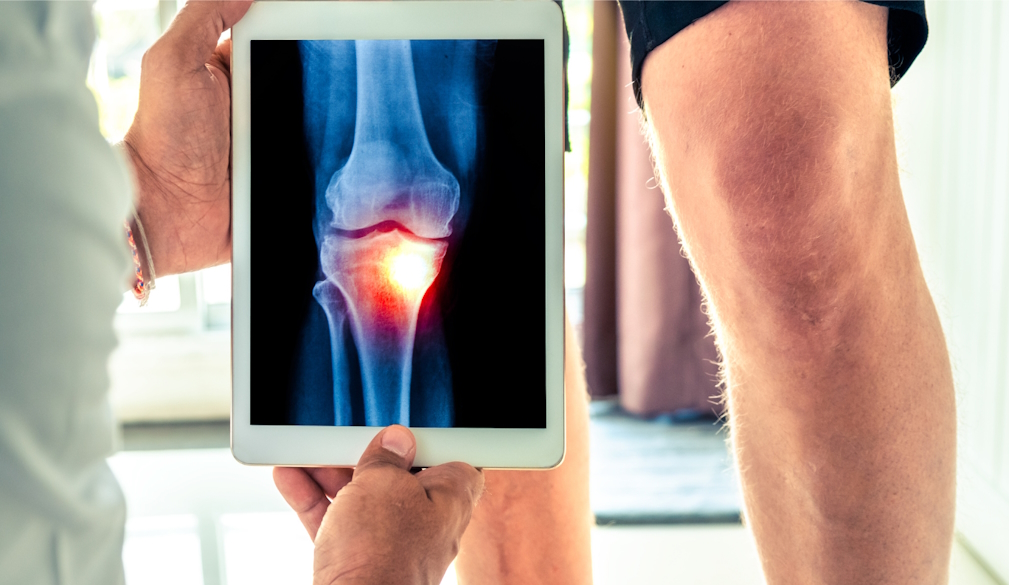Do you have knee pain from osteoarthritis? You might not need surgery. Here’s what to try instead
- Written by Belinda Lawford, Postdoctoral research fellow in physiotherapy, The University of Melbourne

Most people with knee osteoarthritis can control their pain and improve their mobility without surgery, according to updated treatment guidelines[1] from the Australian Commission on Safety and Quality in Health Care.
So what is knee osteoarthritis and what are the best ways to manage it?
More than 2 million Australians have osteoarthritis
Osteoarthritis is the most common joint disease, affecting 2.1 million Australians[2]. It costs the economy[3] A$4.3 billion each year.
Osteoarthritis commonly affects[4] the knees, but can also affect the hips, spine, hands and feet. It impacts the whole joint including bone, cartilage, ligaments and muscles.
Most people with osteoarthritis have persistent pain and find it difficult to perform simple daily tasks, such as walking and climbing stairs.
Is it caused by ‘wear and tear’?
Knee osteoarthritis is most likely to affect older people, those who are overweight or obese, and those with previous knee injuries. But contrary to popular belief, knee osteoarthritis is not caused by[5] “wear and tear”.
Research shows[6] the degree of structural wear and tear visible in the knee joint on an X-ray does not correlate with the level of pain or disability a person experiences. Some people have a low degree of structural wear and tear and very bad symptoms, while others have a high degree of structural wear and tear and minimal symptoms. So X-rays are not required[7] to diagnose knee osteoarthritis or guide treatment decisions.
Telling people they have wear and tear can make them worried about their condition and afraid of damaging their joint. It can also encourage them to try invasive and potentially unnecessary treatments such as surgery. We have shown this[8] in people with osteoarthritis, and other common pain conditions such as back[9] and shoulder[10] pain.
This has led to a global call for a change in the way[11] we think and communicate about osteoarthritis.
Read more: How long does back pain last? And how can learning about pain increase the chance of recovery?[12]
What’s the best way to manage osteoarthritis?
Non-surgical treatments work well for most people with osteoarthritis, regardless of their age or the severity of their symptoms. These include[13] education and self-management, exercise and physical activity, weight management and nutrition, and certain pain medicines.
Education is important to dispel misconceptions about knee osteoarthritis. This includes information about what osteoarthritis is, how it is diagnosed, its prognosis, and the most effective ways to self-manage symptoms.
Health professionals who use positive and reassuring language can improve[14] people’s knowledge and beliefs about osteoarthritis and its management.
Many people believe that exercise and physical activity will cause further damage to their joint. But it’s safe and can reduce pain and disability. Exercise has fewer side effects than commonly used pain medicines such as paracetamol and anti-inflammatories[15] and can prevent or delay[16] the need for joint replacement surgery in the future.
Many types of exercise are effective[17] for knee osteoarthritis, such as strength training, aerobic exercises like walking or cycling, Yoga and Tai chi. So you can do whatever type of exercise best suits you.
Increasing general physical activity is also important, such as taking more steps throughout the day and reducing sedentary time.
Weight management is important for those who are overweight or obese. Weight loss can reduce knee pain and disability[18], particularly when combined with exercise. Losing as little as 5–10% of your body weight can be beneficial[19].
Pain medicines should not replace treatments such as exercise and weight management but can be used alongside these treatments to help manage pain. Recommended medicines[20] include paracetamol and non-steroidal anti-inflammatory drugs.
Opioids are not recommended[21]. The risk of harm outweighs any potential benefits.
What about surgery?
People with knee osteoarthritis commonly undergo two types of surgery: knee arthroscopy and knee replacement.
Knee arthroscopy is a type of keyhole surgery used to remove or repair damaged pieces of bone or cartilage that are thought to cause pain.
However, high-quality research has shown[22] arthroscopy is not effective. Arthroscopy should therefore not be used in the management of knee osteoarthritis.
Joint replacement involves replacing the joint surfaces with artificial parts. In 2021–22, 53,500 Australians[23] had a knee replacement for their osteoarthritis.
Joint replacement is often seen as being inevitable and “necessary”. But most people can effectively manage their symptoms through exercise, physical activity and weight management.
The new guidelines (known as “care standard”) recommend joint replacement surgery only be considered for those with severe symptoms who have already tried non-surgical treatments.
I have knee osteoarthritis. What should I do?
The care standard[24] links to free evidence-based resources to support people with osteoarthritis. These include:
If you have osteoarthritis, you can use the care standard[25] to inform discussions with your health-care provider, and to make informed decisions about your care.
References
- ^ updated treatment guidelines (www.safetyandquality.gov.au)
- ^ 2.1 million Australians (www.aihw.gov.au)
- ^ costs the economy (www.aihw.gov.au)
- ^ affects (pubmed.ncbi.nlm.nih.gov)
- ^ not caused by (pubmed.ncbi.nlm.nih.gov)
- ^ Research shows (pubmed.ncbi.nlm.nih.gov)
- ^ not required (www.safetyandquality.gov.au)
- ^ shown this (pubmed.ncbi.nlm.nih.gov)
- ^ back (www.ncbi.nlm.nih.gov)
- ^ shoulder (pubmed.ncbi.nlm.nih.gov)
- ^ change in the way (pubmed.ncbi.nlm.nih.gov)
- ^ How long does back pain last? And how can learning about pain increase the chance of recovery? (theconversation.com)
- ^ include (www.safetyandquality.gov.au)
- ^ can improve (pubmed.ncbi.nlm.nih.gov)
- ^ paracetamol and anti-inflammatories (pubmed.ncbi.nlm.nih.gov)
- ^ prevent or delay (pubmed.ncbi.nlm.nih.gov)
- ^ are effective (pubmed.ncbi.nlm.nih.gov)
- ^ can reduce knee pain and disability (pubmed.ncbi.nlm.nih.gov)
- ^ can be beneficial (pubmed.ncbi.nlm.nih.gov)
- ^ Recommended medicines (pubmed.ncbi.nlm.nih.gov)
- ^ not recommended (pubmed.ncbi.nlm.nih.gov)
- ^ has shown (pubmed.ncbi.nlm.nih.gov)
- ^ 53,500 Australians (www.aihw.gov.au)
- ^ care standard (www.safetyandquality.gov.au)
- ^ care standard (www.safetyandquality.gov.au)

















